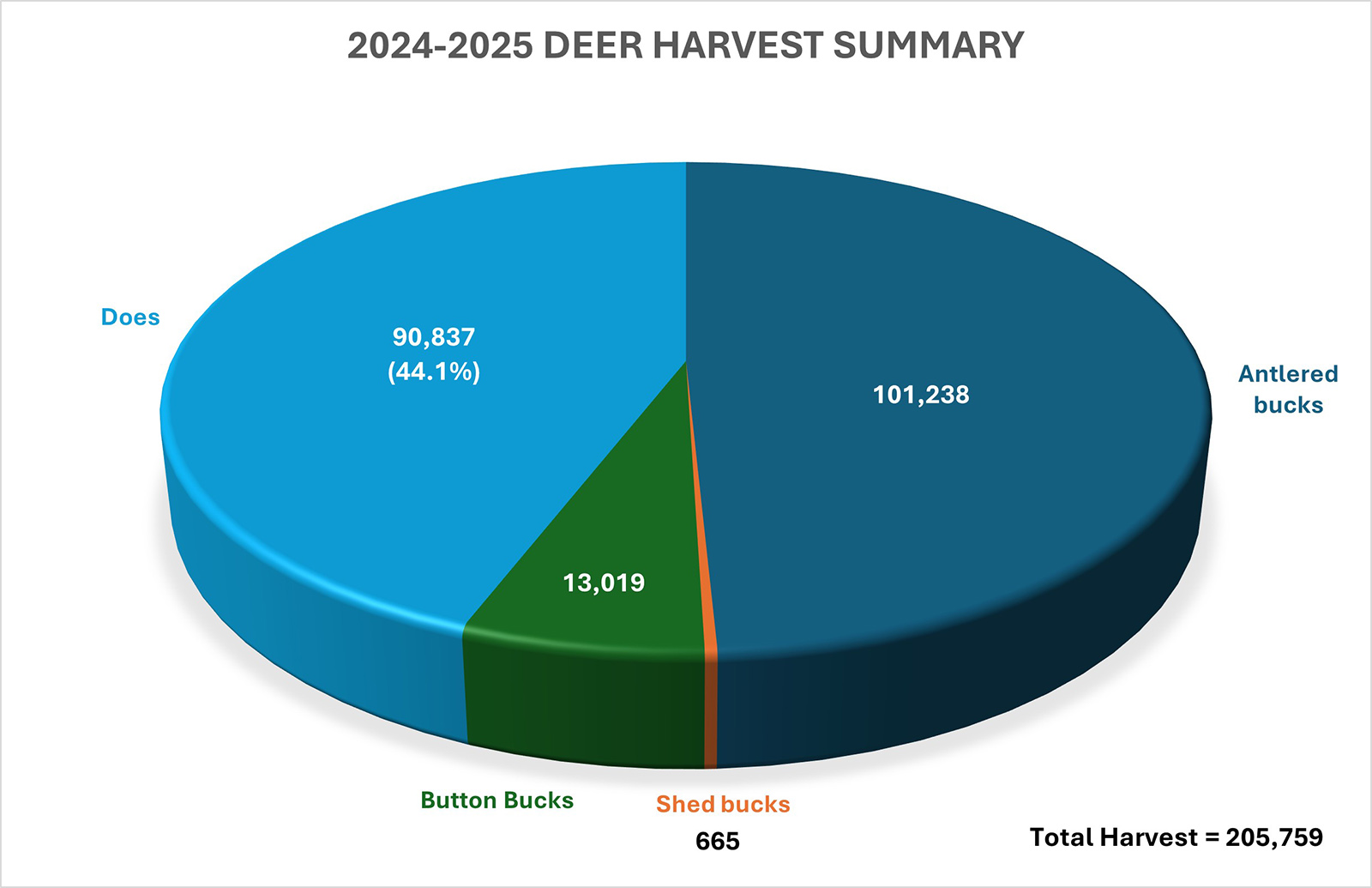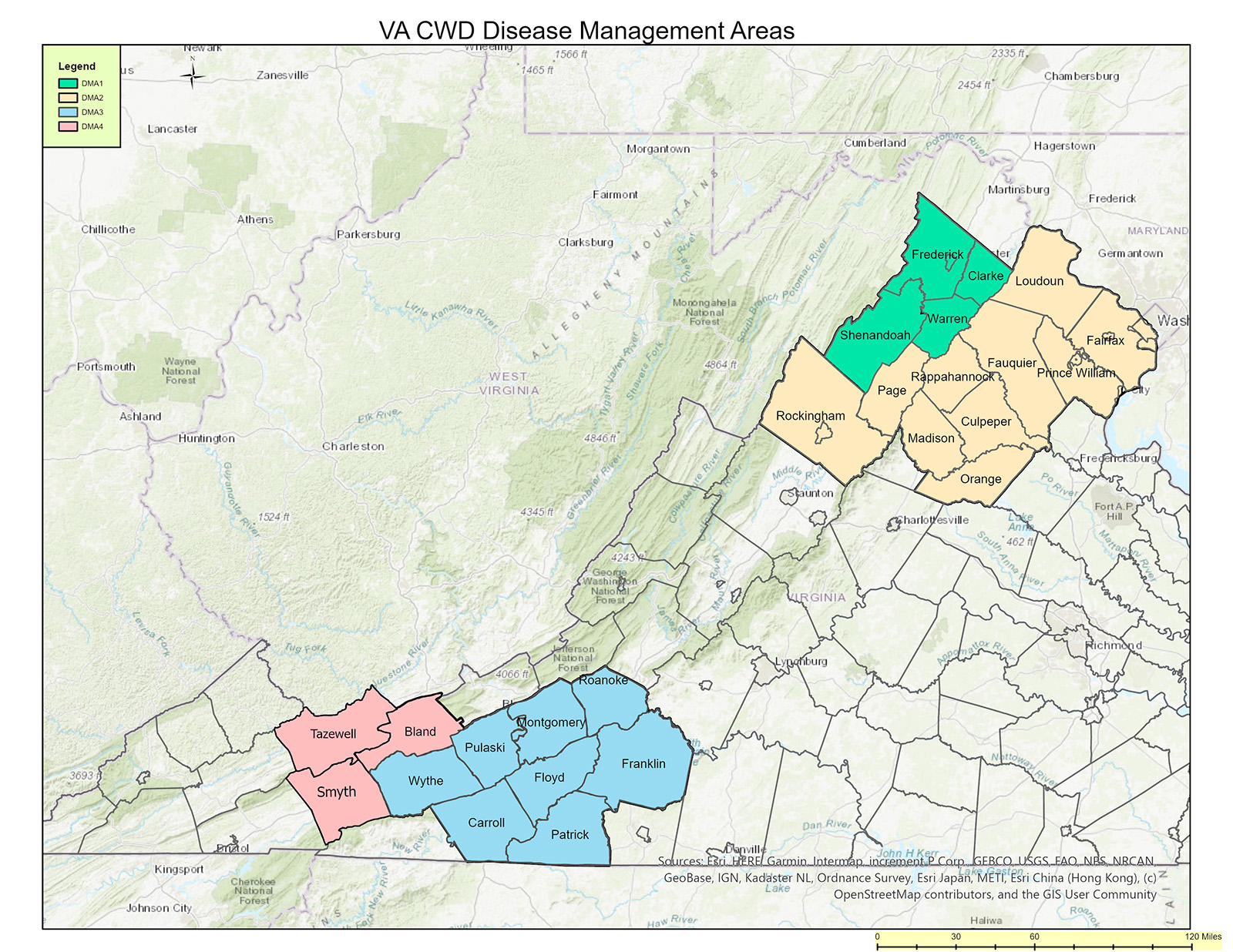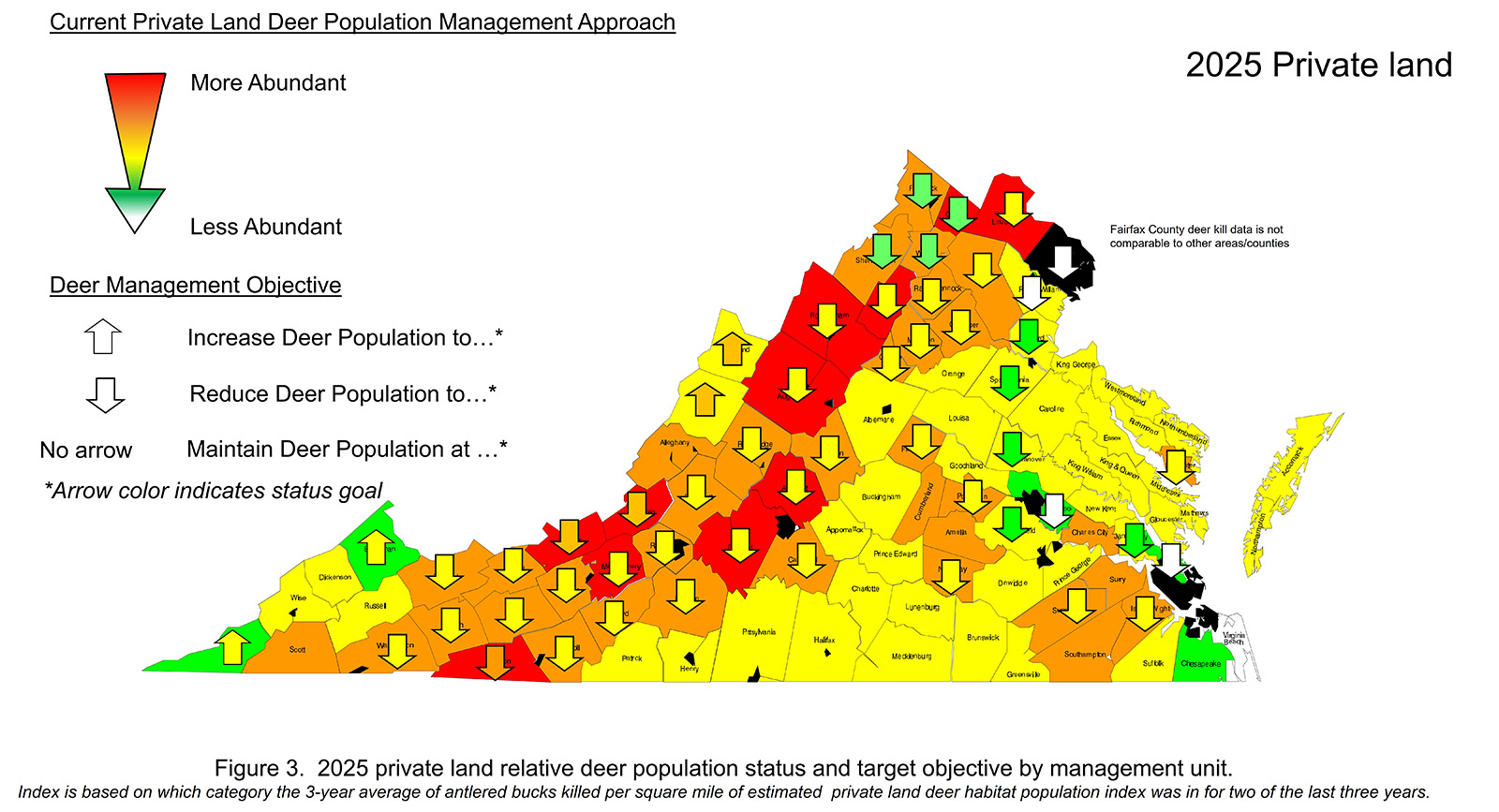2025 Deer Season Forecast
By Justin Folks/DWR
2024-2025 Virginia Deer Season Review
During the past deer season (including the early September antlerless seasons), 205,759 deer were reported harvested by deer hunters in Virginia. This total included 101,238 antlered bucks, 665 shed bucks, 13,019 button bucks, and 90,837 does (44.1% females; Figure 1).

Statewide deer harvest breakdown for the 2024-2025 season.
Archery (including crossbows) accounted for 14% of the deer kill; muzzleloaders, 24%; and firearms, 62%. The youth and apprentice weekend resulted in the harvest of 2,441 deer. When and where deer hunting with dogs is legal, deer taken with the use of dogs made up 52% of the total harvest. The numbers above do not include deer taken on out-of-season deer kill permits or those deer hit and killed by vehicles.
The 2024-2025 deer harvest was nearly the same as the 2023-2024 season and still slightly above the last 10-year average of 198,405. Deer hunters who would like to know the annual deer kill totals by county dating back to 1947, including the county 2024 totals, can find them on the Department’s website.

Chronic Wasting Disease (CWD)
We broke our record for the most positive detections in the state again. Last year, we sampled more than 8,100 deer statewide with 109 positives. A couple of new positives in West Virginia will unfortunately bring Rockingham County into Disease Management Area (DMA) 2.
DMA1 (Clarke, Frederick, Shenandoah, and Warren counties)
Since July 2024, a total of 611 samples were collected within DMA1, which resulted in 79 positive detections. Frederick County unsurprisingly had the most detections (53), while Shenandoah (12), Warren (5), and Clarke (9) each had at least one detection in 2024. There are no changes to the boundaries of DMA1 for the 2025 season.
DMA2 (Arlington, Culpeper, Fairfax, Fauquier, Loudoun, Madison, Orange, Page, Prince William, and Rappahannock, and Rockingham counties)
Since July 2024, 2,959 deer were sampled for CWD in DMA2 with 17 positive detections: 7 positives from Loudoun, 3 each in Madison and Fauquier, 2 in Culpeper, and 1 in Prince William. As stated previously, Rockingham County will be added to DMA2 for the 2025 season due to CWD detections near the border in West Virginia.
DMA3 (Carroll, Floyd, Franklin, Montgomery, Patrick, Pulaski, Roanoke, and Wythe counties)
During the 2024 season, a total of 2,123 samples were taken within DMA3. This sampling effort yielded positive detections in Floyd (5), Montgomery (7), and the first detection in Roanoke (1). The Roanoke positive was an adult buck exhibiting symptoms of late-stage CWD. There will be no changes to DMA3 for the 2025 season.
DMA4 (Bland, Smyth, and Tazewell)
Our highly successful statewide CWD surveillance efforts through cooperating taxidermists led to the detection of a CWD-positive buck in Tazewell County during the 2023 season, prompting the creation of DMA4. We sampled 146 deer this past year in DMA4 with no new positives. No changes to DMA4 for the 2025 season. See Figure 2 for a current map of all DMAs.

Hemorrhagic Disease (HD)
The year 2024 was déjà vu for HD. Weather conditions were very similar west of the Blue Ridge (WBR) to those in 2023 and there were HD outbreaks in some similar locations. HD was a little bit more widespread last year WBR, with confirmed HD deaths (outside of Augusta and Rockingham) in Alleghany, Botetourt, Page, Frederick, the City of Waynesboro, and in Albemarle County.
HD activity in VA is correlated to wet springs followed by hot, dry summers that create ideal breeding conditions (mud flats) for midges that carry the HD viruses. Despite receiving reports of these HD outbreaks, deer harvest numbers at the county level were similar to or greater than those for the same counties the previous year. HD activity is rarer west of the Blue Ridge and typically has a greater impact to deer herds there. Nationwide, deer managers are seeing an increase in HD activity northward, presumably due to changes in climate conditions. If that trend continues, we may be seeing more HD activity WBR in the future.
For more information on HD go to DWR’s website or here.
There have been a substantial number of changes to the deer hunting regulations for the 2025 season, so be sure to read the new regulations thoroughly!
- The firearms season has been extended to four weeks in all or part of 20 counties WBR; several have gone to seven weeks, and Bedford, Franklin, and western Amherst and western Nelson are now seven weeks
- Firearms either-sex days have been increased in 30 counties, Cumberland State Forest, and a few WMAs
- Early and late antlerless-only firearms seasons have been established in Greene, Hanover, Henrico, and James City counties
- Either-sex days have been increased for muzzleloader seasons in Craig and Giles
- Deer of either-sex can now be taken the second Saturday of early muzzleloader and the last day of late muzzleloader in Buchanan County
- Earn-a-buck has been established in Chesterfield, Craig, Giles, and Spotsylvania counties
- Deer harvest reporting will now include a question about outside spread for bucks
- Mandatory CWD Sampling Day will be on November 15, 2025 in Patrick, Roanoke, Shenandoah, Smyth, Tazewell, and Wythe Counties.
Tidewater Forecast
The deer harvest in Tidewater has been fairly stable at between 40,000 to 50,000 deer and most counties are meeting current population objectives; however, the growing human population here is creating significant management challenges. We are implementing EAB in Chesterfield County and the early and late antlerless-only firearms seasons in Hanover, Henrico, and James City to help boost female harvest, but we’ll need hunters to take advantage of urban hunting opportunities to help meet deer management objectives in this rapidly urbanizing region. This is the reality we face in Tidewater and other urban areas across the state.
Most counties in Tidewater are meeting their current population objective as laid out in the current Deer Management Plan, but these objectives may change with the new Deer Plan in the next year or two.
Southern Piedmont Forecast
If there is not a big HD event in this area in fall 2024, deer herds over most of this region should be relatively stable. The Southern Piedmont has had the highest deer kill across all regions since 2020, with Bedford County having the highest total statewide at almost 8,000 deer harvested. As shown in Figure 3, more than half of the deer herds in the Southern Piedmont are at their desired deer population level, but there’s work to be done in Bedford, Franklin, and Campbell.
Northern Piedmont Forecast
Over most of the Northern Piedmont, DWR continues to try reducing the deer population (see Figure 3), especially in Northern Virginia (NOVA; Arlington, Fairfax, Loudoun, and Prince William counties) and in CWD DMA2. For the most part, the ultra-liberal NOVA deer seasons have been successful in reducing deer herds in Loudoun and Prince William, but not quite to the desired levels.
Stable to declining deer herds are expected and desired moving forward. Continued very high human population growth rates and deer-vehicle collisions remain important deer management issues in the Northern Piedmont (like Tidewater), and CWD is an ever-increasing problem here as well.
Northern Mountains Forecast
As noted at the beginning of this article, CWD is a big issue in the Northern Mountains. On private lands in every county in the Shenandoah Valley, DWR is trying to reduce deer herds. Conversely, in the three Alleghany Highland counties (Alleghany, Bath, and Highland), DWR is trying to maintain moderate to high population levels (orange). Approximately two decades ago, all three of these counties exhibited a significant decline in deer populations. Since that time, regulations have been made more conservative and deer populations have stabilized and/or increased. Higher deer populations are desired and tolerated in the Alleghany Highlands because there are fewer people and not a lot of deer-human conflicts.
We had HD outbreaks in the Shenandoah Valley the past two years, but deer harvest numbers were similar to previous years at the county level. I don’t expect a big decline (if any) in deer numbers at the region or county level, but locally, some hunters may not see as many deer as in previous years.
Southern Mountains Forecast
The Southern Mountains are best described by three different deer management approaches. In nearly all the counties in the New River Valley area, DWR is trying to reduce deer populations. In the far southwest, DWR is trying to maintain current/stable deer populations, and lastly, in Buchanan and Lee counties, DWR is still trying to increase deer populations. These efforts have been and continue to be successful, and we’ve been able to add some either-sex harvest opportunity in far southwest during this recent regulations cycle.
Relative Deer Abundance Map
The best way to compare deer populations in Virginia is based on the antlered buck deer harvest per square mile of estimated deer habitat. This is the population index we use to monitor deer population trends over time. Figure 3 shows the relative differences among counties in the kill of antlered bucks per square mile of habitat on private land, averaged over the past three hunting seasons. Note there are 97 major deer management units in Virginia.
In 49 units, DWR is actively managing to reduce deer populations. In 44 management units, DWR is actively managing to maintain current deer population levels; and lastly, in only four management units, DWR is actively managing to increase deer numbers.

Summary
So, what is the forecast for the fall 2025 deer season? Unless there is a significant HD event, deer populations and the deer harvest across most of the state should be stable to increasing. An increase in the statewide deer kill total is likely (due to the new regulation changes), and we hope to meet management objectives in more counties as a result. Over the past 30 years, the statewide annual deer kill has been relatively stable and ranged from about 179,000 to 259,000 and averaged about 212,000.
Some deer in our western mountains may have had a rough winter as there were a couple/few weeks in a row where temperatures didn’t get above freezing, but those fortunate enough to be in pockets with above-average mast and diverse habitats should have fared well.
Past experience indicates that the ups and downs in annual deer harvest totals are in part attributable to mast conditions and/or HD outbreaks, neither of which we can predict. In years of poor mast crops, the deer harvest typically goes up. In years of good mast crops, the deer harvest typically goes down. Last year’s mast crop was spotty, and we had a relatively good deer harvest.
Stay tuned for our annual acorn report in October!
Persons interested in more information on Virginia’s deer management program can check out DWR’s deer management plan. Please support the Virginia Hunters for the Hungry program, do not feed the deer, leave no trace, and, most importantly, be safe.
Justin Folks is DWR’s deer project leader.
Legal Disclaimer:
EIN Presswire provides this news content "as is" without warranty of any kind. We do not accept any responsibility or liability for the accuracy, content, images, videos, licenses, completeness, legality, or reliability of the information contained in this article. If you have any complaints or copyright issues related to this article, kindly contact the author above.
